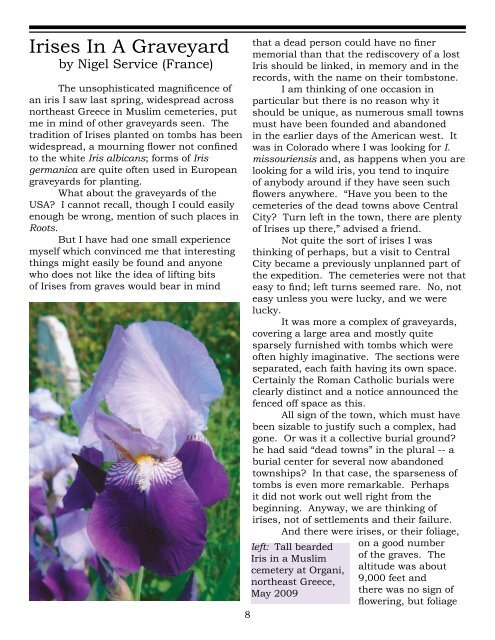roots - Historic Iris Preservation Society
roots - Historic Iris Preservation Society
roots - Historic Iris Preservation Society
You also want an ePaper? Increase the reach of your titles
YUMPU automatically turns print PDFs into web optimized ePapers that Google loves.
<strong>Iris</strong>es In A Graveyard<br />
by Nigel Service (France)<br />
The unsophisticated magnificence of<br />
an iris I saw last spring, widespread across<br />
northeast Greece in Muslim cemeteries, put<br />
me in mind of other graveyards seen. The<br />
tradition of <strong>Iris</strong>es planted on tombs has been<br />
widespread, a mourning flower not confined<br />
to the white <strong>Iris</strong> albicans; forms of <strong>Iris</strong><br />
germanica are quite often used in European<br />
graveyards for planting.<br />
What about the graveyards of the<br />
USA? I cannot recall, though I could easily<br />
enough be wrong, mention of such places in<br />
Roots.<br />
But I have had one small experience<br />
myself which convinced me that interesting<br />
things might easily be found and anyone<br />
who does not like the idea of lifting bits<br />
of <strong>Iris</strong>es from graves would bear in mind<br />
8<br />
that a dead person could have no finer<br />
memorial than that the rediscovery of a lost<br />
<strong>Iris</strong> should be linked, in memory and in the<br />
records, with the name on their tombstone.<br />
I am thinking of one occasion in<br />
particular but there is no reason why it<br />
should be unique, as numerous small towns<br />
must have been founded and abandoned<br />
in the earlier days of the American west. It<br />
was in Colorado where I was looking for I.<br />
missouriensis and, as happens when you are<br />
looking for a wild iris, you tend to inquire<br />
of anybody around if they have seen such<br />
flowers anywhere. “Have you been to the<br />
cemeteries of the dead towns above Central<br />
City? Turn left in the town, there are plenty<br />
of <strong>Iris</strong>es up there,” advised a friend.<br />
Not quite the sort of irises I was<br />
thinking of perhaps, but a visit to Central<br />
City became a previously unplanned part of<br />
the expedition. The cemeteries were not that<br />
easy to find; left turns seemed rare. No, not<br />
easy unless you were lucky, and we were<br />
lucky.<br />
It was more a complex of graveyards,<br />
covering a large area and mostly quite<br />
sparsely furnished with tombs which were<br />
often highly imaginative. The sections were<br />
separated, each faith having its own space.<br />
Certainly the Roman Catholic burials were<br />
clearly distinct and a notice announced the<br />
fenced off space as this.<br />
All sign of the town, which must have<br />
been sizable to justify such a complex, had<br />
gone. Or was it a collective burial ground?<br />
he had said “dead towns” in the plural -- a<br />
burial center for several now abandoned<br />
townships? In that case, the sparseness of<br />
tombs is even more remarkable. Perhaps<br />
it did not work out well right from the<br />
beginning. Anyway, we are thinking of<br />
irises, not of settlements and their failure.<br />
And there were irises, or their foliage,<br />
left: Tall bearded<br />
<strong>Iris</strong> in a Muslim<br />
cemetery at Organi,<br />
northeast Greece,<br />
May 2009<br />
on a good number<br />
of the graves. The<br />
altitude was about<br />
9,000 feet and<br />
there was no sign of<br />
flowering, but foliage











